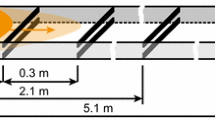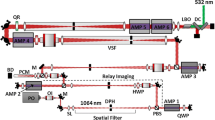Abstract
For stoichiometric C2H4–O2 and C2H2–O2 mixtures with or without argon dilution, the processes of detonation diffraction have been investigated in a two-dimensional setup through high-speed schlieren imaging, with the characteristic length and the stability of detonation varied by regulating the initial pressure and argon mole fraction of the mixture. In particular, a length relevant to the process of supercritical diffraction (i.e., distance from the channel end corner to reflection point of the transverse detonation on the channel end face, reflection point distance in short) was deduced from obtained sequential schlieren images and analyzed. The reflection point distance can be idealized for the infinitely wide donor channel, and thus, it can be a parameter in which properties intrinsic to each detonable mixture are manifested. Experimental results showed that the reflection point distance was roughly inversely proportional to the initial pressure for identical mixtures and independent of the width of the donor channel at high initial pressures. For a certain combination of the fuel and oxidizer, correlations between the reflection point distance and the initial partial pressure of fuel were very similar regardless of the argon mole fraction. Critical conditions of the diffraction problem could be given for the ratio of the reflection point distance to the channel width, and it was suggested that the critical value lies in a range of 3–5 and does not significantly depend on the stability of the mixture.











Similar content being viewed by others
Abbreviations
- D CJ :
-
Chapman–Jouguet (CJ) velocity
- d dt :
-
Diameter of detonation tube
- E a :
-
Activation energy
- p 0 :
-
Initial pressure of mixture
- p 0,f :
-
Initial partial pressure of fuel
- l c :
-
Channel width
- l r :
-
Reflection point distance
- R :
-
Universal gas constant
- T 0 :
-
Initial temperature
- T vN :
-
von Neumann temperature
- t oc :
-
Depth of observation chamber
- y Ar :
-
Argon mole fraction
- λ :
-
Detonation cell width
- τ i :
-
Induction time
- τ r :
-
Reaction time
- χ :
-
Detonation stability parameter
References
Lee, J.H.S.: On the critical diameter problem. In: Bowen, J.R. (ed.) Dynamics of Exothermicity, pp. 321–335. Gordon and Breach Publishers, Netherlands (1996)
Lee, J.H.S.: The Detonation Phenomena. Cambridge University Press, New York (2008). https://doi.org/10.1017/CBO9780511754708
Zel’dovich, Y.B., Kogarko, S.M., Simonov, N.N.: An experimental investigation of spherical detonation in gases. Sov. Phys. Tech. Phys. 1, 1689–1713 (1957)
Lee, J.H.S.: Dynamic parameter of gaseous detonations. Ann. Rev. Fluid Mech. 16, 311–336 (1984). https://doi.org/10.1146/annurev.fl.16.010184.001523
Matsui, H., Lee, J.H.: On the measure of the relative detonation hazards of gaseous fuel oxygen and air mixtures. Symp. Int. Combust. 17, 1269–1280 (1978). https://doi.org/10.1016/S0082-0784(79)80120-4
Mitrofanov, V.V., Soloukhin, R.I.: The diffraction of multi-front detonation waves. Sov. Phys. Dokl. 9, 1055–1058 (1965)
Edwards, D.H., Thomas, G.O., Nettleton, M.A.: The diffraction of a planar detonation wave at an abrupt area change. J. Fluid Mech. 95, 79–96 (1979). https://doi.org/10.1017/S002211207900135X
Edwards, D.H., Thomas, G.O., Nettleton, M.A.: Diffraction of planar detonation in various fuel–oxygen mixtures at an area change. Gasdynamics of Detonations and Explosions. Prog. Astronaut. Aeronaut AIAA 75, 341–357 (1981). https://doi.org/10.2514/5.9781600865497.0341.0357
Moen, I.O., Murray, S.B., Bjerketvedt, D., Rinnan, A., Knystautas, R., Lee, J.H.: Diffraction of detonation initiation from tubes into a large fuel–air explosive cloud. Symp. Int. Combust. 19, 635–645 (1982). https://doi.org/10.1016/S0082-0784(82)80238-5
Knystautas, R., Lee, J.H.S., Guirao, C.M.: The critical tube diameter for detonation failure in hydrocarbon–air mixture. Combust. Flame 48, 63–83 (1982). https://doi.org/10.1016/0010-2180(82)90116-X
Liu, Y.K., Lee, J.H., Knystautas, R.: Effect of geometry on the transmission of detonation through an orifice. Combust. Flame 56, 215–225 (1984). https://doi.org/10.1016/0010-2180(84)90038-5
Benedick, W.B., Knystautas, R., Lee, J.H.S.: Large-scale experiments on the transmission of fuel–air detonations from two-dimensional channels. Dynamics of Shock Waves, Explosions, and Detonations. Prog. Astronaut. Aeronaut. AIAA 94, 546–555 (1984). https://doi.org/10.2514/5.9781600865695.0546.0555
Thomas, G.O., Edwards, D.H., Lee, J.H., Knystautas, R., Moen, I.O., Wei, Y.M.: Detonation diffraction by divergent channels. Dynamics of Explosions. Prog. Astronaut. Aeronaut. AIAA 106, 144–154 (1986). https://doi.org/10.2514/5.9781600865800.0144.0154
Shepherd, J.E., Moen, I.O., Murray, S.B., Thibault, P.A.: Analyses of the cellular structure of detonations. Symp. Int. Combust. 21, 1649–1658 (1986). https://doi.org/10.1016/S0082-0784(88)80398-9
Moen, I.O., Sulmistras, A., Thomas, G.O., Bjerketvedt, D., Thibault, P.A.: Influence of cellular regularity on the behavior of gaseous detonations. Dynamics of Explosions. Prog. Astronaut. Aeronaut. AIAA 106, 220–243 (1986). https://doi.org/10.2514/5.9781600865800.0220.0243
Desbordes, D., Gauerraud, C., Hamada, L., Presles, H.N.: Failure of the classical dynamic parameters relationships in highly regular cellular detonation systems. Dynamic Aspects of Detonations. Prog. Astronaut. Aeronaut. AIAA 153, 347–359 (1993). https://doi.org/10.2514/5.9781600866265.0347.0359
Meredith, J., Ng, H.D., Lee, J.H.: Detonation diffraction from an annular channel. Shock Waves 20, 449–455 (2010). https://doi.org/10.1007/s00193-010-0256-0
Arienti, M., Shepherd, J.E.: A numerical study of detonation diffraction. J. Fluid Mech. 529, 117–146 (2005). https://doi.org/10.1017/S0022112005003319
Eckett, C.A., Quirk, J.J., Shepherd, J.E.: The role of unsteadiness in direct initiation of gaseous detonations. J. Fluid Mech. 421, 147–183 (2000). https://doi.org/10.1017/S0022112000001555
Radulescu, M.I., Lee, J.H.S.: The failure mechanism of gaseous detonations: experiments in porous wall tubes. Combust. Flame 131, 29–46 (2002). https://doi.org/10.1016/S0010-2180(02)00390-5
Bartlmä, F., Schröder, K.: The diffraction of a plane detonation wave at a convex corner. Combust. Flame 66, 237–248 (1986). https://doi.org/10.1016/0010-2180(86)90137-9
Jones, D.A., Kemister, G., Oran, E.S., Sichel, M.: The influence of cellular structure on detonation transmission. Shock Waves 6, 119–129 (1996). https://doi.org/10.1007/BF02510992
Pintgen, F., Shepherd, J.E.: Detonation diffraction in gases. Combust. Flame 156, 665–677 (2009). https://doi.org/10.1016/j.combustflame.2008.09.008
Deiterding, R.: High-resolution numerical simulation and analysis of Mach reflection structures in detonation waves in low-pressure H2–O2–Ar mixtures: a summary of results obtained with the adaptive mesh refinement framework AMROC. J. Combust. 2011, Article ID 738969 (2011). http://dx.doi.org/10.1155/2011/738969
Li, J., Ning, J., Kiyanda, C.B., Ng, H.D.: Numerical simulations of cellular detonation diffraction in a stable gaseous mixture. Propul. Power Res. 5, 177–183 (2016). https://doi.org/10.1016/j.jppr.2016.07.004
Mehrjoo, N., Zhang, B., Portaro, R., Ng, H.D., Lee, J.H.S.: Response of critical tube diameter phenomenon to small perturbations for gaseous detonations. Shock Waves 24, 219–229 (2014). https://doi.org/10.1007/s00193-013-0491-2
Mehrjoo, N., Gao, Y., Kiyanda, C.B., Ng, H.D., Lee, J.H.S.: Effects of porous walled tubes on detonation transmission into unconfined space. Proc. Combust. Inst. 35, 1981–1987 (2015). https://doi.org/10.1016/j.proci.2014.06.031
Murray, S.B., Lee, J.H.S.: On the transformation of planar detonation to cylindrical detonation. Combust. Flame 52, 269–289 (1983). https://doi.org/10.1016/0010-2180(83)90138-4
Nagura, Y., Kasahara, J., Sugiyama, Y., Matsuo, A.: Comprehensive visualization of detonation–diffraction structure and sizes in unstable and stable mixtures. Proc. Combust. Inst. 34, 1949–1956 (2013). https://doi.org/10.1016/j.proci.2012.07.078
Nagura, Y., Kasahara, J., Matsuo, A.: Multi-frame visualization for detonation wave diffraction. Shock Waves 26, 645–656 (2016). https://doi.org/10.1007/s00193-016-0663-y
Gordon, S., McBride, B.J.: Computer Program for Calculation Complex Chemical Equilibrium Compositions and Applications—I. Analysis. NASA Reference Publication 1311 (1994)
Gordon, S., McBride, B.J.: Computer Program for Calculation Complex Chemical Equilibrium Compositions and Applications—II. User’s Manual and Program Description. NASA Reference Publication 1311 (1996)
Ng, H.D., Higgins, A.J., Kiyanda, C.B., Radulescu, M.I., Lee, J.H.S., Bates, K.R., Nikiforakis, N.: Non-linear dynamics and chaos analysis of one-dimensional pulsating detonations. Combust. Theory Model. 9, 159–170 (2005). https://doi.org/10.1080/13647830500098357
Browne, S., Ziegler, J., Shepherd, J.E.: Numerical Solution Methods for Shock and Detonation Jump Conditions. GALCIT Report FM2006.006 (Revised) (2015)
Smith, G.P., Golden, D.M., Frenklach, M., Moriarty, N.W., Eiteneer, B., Goldenberg, M., Bowman, C.T., Hanson, R.K., Song, S., Gardiner, W.C., Jr., Lissianski, V.V., Qin, Z.: GRI-Mech 3.0. http://combustion.berkeley.edu/gri-mech/version30/text30.html
Strehlow, R.A.: Gas phase detonations: Recent developments. Combust. Flame 12, 81–101 (1968). https://doi.org/10.1016/0010-2180(68)90083-7
Kaneshige, M., Shepherd, J.E.: Detonation Database. GALCIT Technical Report FM97-8 (1997)
Strehlow, R.A.: Transverse waves in detonations: II. Structure and spacing in H2–O2, C2H2–O2, C2H4–O2, and CH4–O2 systems. AIAA J. 7(3), 492–496 (1969). https://doi.org/10.2514/3.5134
Abid, S., Dupre, G., Paillard, C.: Oxidation of gaseous unsymmetrical dimethylhydrazine at high temperatures and detonation of UDMH/O2 mixtures. Dynamic Aspects of Detonations. Prog. Astronaut. Aeronaut. AIAA 153, 162–181 (1991). https://doi.org/10.2514/5.9781600866265.0162.0181
Auffret, Y., Desbordes, D., Presles, H.N.: Detonation structure of C2H4–O2–Ar mixtures at elevated initial temperature. Shock Waves 9, 107–111 (1999). https://doi.org/10.1007/s001930050145
Denisov, Y.N., Troshin, Y.K.: Structure of gaseous detonation in tubes. Sov. Phys. Tech. Phys. 5(4), 419–431 (1960)
Manzhalei, V.I., Mitrofanov, V.V., Subbotin, V.A.: Measurement of inhomogeneities of a detonation front in gas mixtures at elevated pressures. Combust. Explos. Shock Waves (USSR) 10(1), 89–95 (1974). https://doi.org/10.1007/BF01463793
Edwards, D.H., Hooper, G., Morgan, J.M., Thomas, G.O.: The quasi-steady regime in critically initiated detonation waves. J. Phys. D 11(13), 2103–2117 (1978). https://doi.org/10.1088/0022-3727/11/15/008
Vasil’ev, A.A., Grigor’ev, V.V.: Critical conditions for gas detonation in sharply expanding channels. Combust. Explos. Shock Waves (USSR) 16(5), 579–585 (1980). https://doi.org/10.1007/BF00794938
Desbordes, D., Vachon, M.: Critical diameter of diffraction for strong plane detonations. Dynamics of Explosions. Prog. Astronaut. Aeronaut. AIAA 106, 131–143 (1986). https://doi.org/10.2514/5.9781600865800.0131.0143
Desbordes, D.: Transmission of overdriven plane detonations: critical diameter as a function of cell regularity and size. Dynamics of Explosions. Prog. Astronaut. Aeronaut. AIAA 114, 170–185 (1988). https://doi.org/10.2514/5.9781600865886.0170.0185
Laberge, S., Knystautas, R., Lee, J.H.S.: Propagation and extinction of detonation waves in tube bundles. Dynamic Aspects of Detonations. Prog. Astronaut. Aeronaut. AIAA 153, 381–396 (1993). https://doi.org/10.2514/5.9781600866265.0381.0396
Schultz, E., Shepherd, J.E.: Detonation Diffraction Through a Mixture Gradient. GALCIT Report FM2006.008 (2008)
Shepherd, J.E., Schultz, E., Akbar, R.: Detonation diffraction. Proceedings of the International Symposium on Shock Waves. Imperial College, London (1999)
Gallier, S., Le Palud, F., Pintgen, F., Mével, R., Shepherd, J.E.: Detonation wave diffraction in H2–O2–Ar mixtures. Proc. Combust. Inst. 36, 2781–2789 (2017). https://doi.org/10.1016/j.proci.2016.06.090
Acknowledgements
The authors thank Ken Matsuoka and Akira Iwakawa for fruitful discussions. This research was financially supported by the Nitto Foundation and the Japanese Society for the Promotion of Science (JSPS) KAKENHI Grant Numbers 17H06741, 17H03480, and 17K18937.
Author information
Authors and Affiliations
Corresponding author
Additional information
Communicated by A. Higgins.
Publisher’s Note
Springer Nature remains neutral with regard to jurisdictional claims in published maps and institutional affiliations.
Electronic supplementary material
Below is the link to the electronic supplementary material.
Rights and permissions
About this article
Cite this article
Kawasaki, A., Kasahara, J. A novel characteristic length of detonation relevant to supercritical diffraction. Shock Waves 30, 1–12 (2020). https://doi.org/10.1007/s00193-019-00890-7
Received:
Revised:
Accepted:
Published:
Issue Date:
DOI: https://doi.org/10.1007/s00193-019-00890-7




